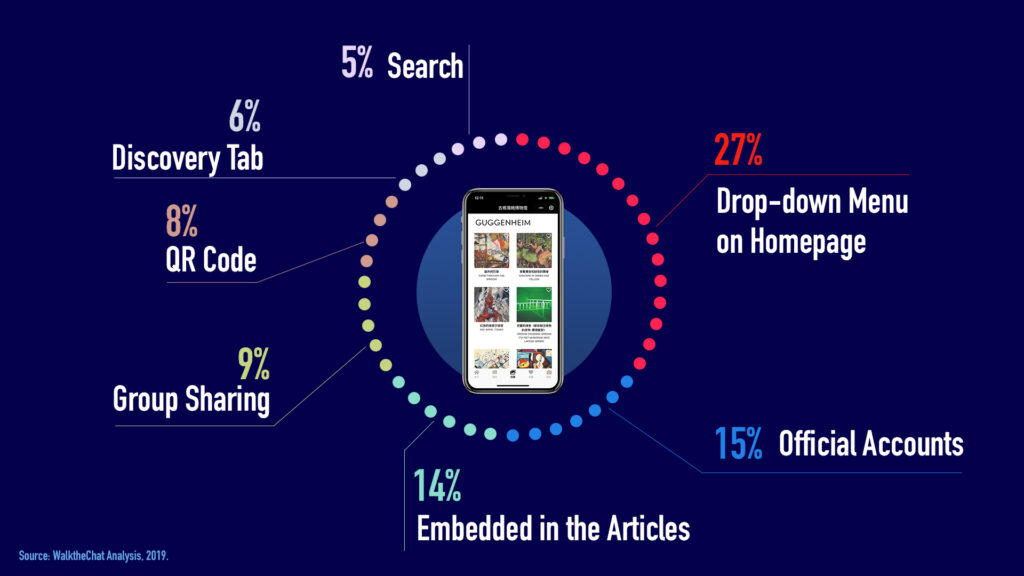This article is part of a series looking at Mini Programs in the context of cultural institutions, check out the other stories here.
In early 2017, Tencent created Mini Programs, non downloadable apps that live inside WeChat’s ecosystem. The development revolutionized China’s internet landscape by offering a simple and cost effective way for companies to provide services on a platform that is ubiquitous in the country.
Although the e-commerce and gaming industries have embraced Mini Programs with particular enthusiasm — representing 42 percent and 28 percent of Mini Programs that WeChat users follow — China’s cultural institutions have also leveraged Tencent’s creation to upload digital resources, reach new audiences, and enhance their onsite experiences.
Increasingly, overseas attractions and destinations are also launching Mini Programs as a dynamic and economic way to connect with Chinese audiences.
But how, exactly do you build a Mini Program?
Jing Travel spoke to Jessica Dai of China Luxury Advisors, the agency responsible for the Mini Programs of MoMA, the Guggenheim, and the Asian Art Museum, to break down the process from registration to execution.
Why should cultural organizations be thinking about Mini Programs?
It’s a smooth and polished user experience, there’s no need to install, users have fast access and no commitment. There is a lot of data you can gather on users compared to physical print material traditionally used by museums and this helps get a strong understanding about Chinese visitors.
How do you convince cultural clients?
Often, clients are interested in the Chinese market and want to build a presence but don’t know where to start. A lot of museums don’t realize that efforts on Youtube and Google are not getting translated into China. You need to build a China-specific presence, some will argue, we are not doing anything specific for the European market or the Latin American market, why do we need something special for China?
So you’ve convinced them! What’s the first step?
Registration is the first step. We give them the paperwork, they gather their assets for us, and once we have that we submit it to WeChat. There’s sometimes a back and forth with the WeChat verification agency.
Once registered, how does the planning happen?
We show clients different types of Mini Programs for inspiration, including e-commerce, ticket and booking, educational, or audio guides. Then we have a brainstorm session to create a functions wish list — setting aside budget and technical limitations.
So, you have goals and a functions wish list, what’s next?
We’ll talk internally with the development team to narrow down the wish list and see what is technically achievable and what the cost is going to be. Next, we do the mockup and water frame process, using the assets that museums provide us.
Is this a heavy lift for your cultural clients?
I don’t think so. They usually don’t have a dedicated staff so it’s either the content manager or the marketing manager interfacing with us and responsible for gathering the resources from different departments and getting clearance.
How long does it take to build a Mini Program?
It depends on how complicated the program is, it can take somewhere between three and six months. Once we have a clear roadmap, the mockups can take less than a month, the development takes two to three weeks. Most of the time is spent not translating and developing, but getting permission for the artwork.
How much does it cost to build a Mini Program?
Developing [a Mini Program] can cost anywhere between 3,000 and 20,000 [Dollars]. Something following a WeChat Mini Program template is on the lower end and something that is highly customized that we have to build from scratch is on the higher end.

Mini Programs have more than 300 million daily active users. Image: Peter Huang
What data does a Mini Program provide?
The benchmarks we are using right now are; visitation numbers, new users, returning visitors, visitation each month, the source of visitation, what gateway they are coming through, the duration of visit, and how deeply they are engaging with the mini program.
What about revenue generation?
We are in discussion about integrating e-commerce or ticketing elements into Mini Programs. It sounds easy but in terms of integration, many museums have pretty antiquated systems, connecting WeChat to their internal system without creating a lot of work is a hurdle we have to overcome.
Why do you think relatively few overseas museums have launched Mini Programs?
Some museums have told me that anything they do on WeChat or in the China market has to be profitable, it’s not like some luxury brand that can throw 30K behind some effort that is more of a brand play than a revenue generator, so for museums it’s important that it is sustainable which explains the caution.



